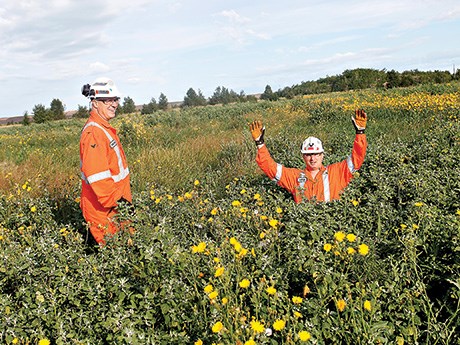Vegetative cover controls dust, segregates acidic waste, contributes to the regreening of mining lands
The successful greening of Vale’s Central Tailings Facility in Sudbury – at 6,000 acres, one of the largest tailings facilities in North America – serves as a model for mining companies around the world looking to remediate barren landscapes and eliminate the risk of acid mine drainage and dam failures.
Glen Watson, Vale’s superintendent of environment, decommissioning and reclamation, attributes much of the successful regreening to the use of some 80,000 wet tonnes of municipal biosolids trucked to Sudbury from southern Ontario since 2014.
In addition to contributing to the regreening of Sudbury, the use of biosolids on tailings and other mine-impacted lands offers municipalities in southern Ontario a biosolids management alternative in the winter and during heavy rains when application of the material on farmers’ fields is prohibited.
Landfills are the only answer during these prohibited periods, but there’s a lot of pressure on landfills across Ontario, said Watson. “Very few are being permitted and tipping fees are pricey, so diverting biosolids from landfills is something the province is very interested in.”
The use of biosolids on mining lands is so highly thought of that Vale and Terratec Environmental, the company that supplies and trucks the biosolids to Sudbury, were co-winners of the 2018 Exemplary Biosolids Management Award from the Water Environment Association of Ontario.
Watson explains that there are two classes of biosolids. Class A material is treated to eliminate pathogen content and sold primarily for agricultural use. Class B biosolids, by contrast, are anaerobically digested and dewatered and contain pathogens. Municipalities pay companies like Terratec Environmental to collect it and give it away for free. It’s the latter class B product that Vale uses.
The City of Sudbury has a biosolids plant producing Class A material and pulp and paper companies have in the past offered their waste to Vale, but both products come with a cost for either the material itself or the transportation.
Tailings revegetation is nothing new, acknowledged Watson. “Forty years ago, Inco’s Tom Peters pioneered a tailings revegetation approach by amending the surface of the tails much like a farmer would.”
READ: Another blockbuster issue of SMSJ
“He limed it to bring the pH up, fertilized it and planted trees. He was successful, and we still have stands of trees that are 30 to 40 feet high as evidence of his success. The problem is that it was bloody expensive, and while we continued that practice in small pockets over time, biosolids are a better solution.”
In addition to providing the nutrient rich material needed, the biosolids also assist with dust control.
“Tailings are a very fine, sandy material that can get entrained in the air very easily,” said Watson. “We control dust using straw and dust control chemicals, but establishing a vegetative cover is a more permanent solution.”
One of the few problems associated with the use of biosolids is the smell, so Watson and his team pay close attention to wind direction when it’s applied and use straw and hay for odour control.
Vale’s recipe for a growth medium was further enhanced when the City of Sudbury offered up its leaf and yard waste. The seeds in the straw, hay and yard waste suffice for plant growth.
“The results are so impressive that last year we baled hay,” said Watson. “We got 10 to 15 centimeters of soil depth after 40 years (from earlier regreening efforts), and we get that in about four years (using biosolids), so it’s very encouraging.”
Traditionally, the proven method for segregating sulfide waste and preventing acid mine drainage is a water cover, but water covers in tailings dams poses a risk to geotechnical stability, requiring very close attention to dam safety, said Watson.
“For long-term closure, we should start looking at dry covers versus wet covers, so while biosolids are now focused on preventing dust, I think there’s a lot of promise to providing a long-term sustainable dry cover.
Terratec also supplies biosolids to the Ministry of Northern Development and Mines for the remediation of the Kam Kotia tailings area near Timmins. The site of one of Ontario’s worst environmental disasters contains some six million tonnes of acid generating tailings covering 1,235 acres, resulting in a wasteland devoid of vegetation and wildlife.
The regreened sections of Vale’s Central Tailings Facility, by contrast, are lush with vegetation and home to flocks of Canada geese, sandhill cranes, black bears and white tail deer.



